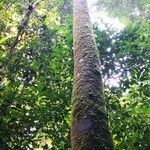Trees to 12 m tall; twigs hollow, smooth or with small lenticels, puberulent to glabrous, dark brown. Leaves in (3-)5 rows; petioles 2.5-4 cm, with deep groove, glabrous; leaf blade obovate or oblanceolate, (12-)28-55 × 5-15 cm, papery, both surfaces glabrous except sometimes midvein pubescent, base narrowed and then acute, or broadly cuneate, apex acute or shortly acuminate, sometimes blunt; lateral veins 14-18 pairs, midvein raised abaxially, sunken adaxially, tertiary veins sparse, nearly parallel, obscure. Plants dioecious. Male inflorescences axillary or arising from axils of deciduous leaves, 9-15 cm, tomentulose to nearly glabrous. Male flowers: pedicel slender, 1-2 mm, nearly as long as flowers; bud globose, 3-or 4-angled, leathery when dry, lobes (2 or)3 or 4(or 5), splitting bud to ca. 3/4; anthers 12-20, connate into globose synandrium. Female inflorescences 3-7 cm, branched. Female flowers: buds nearly globose or obovoid, ca. 5 mm, larger than male, not clustered, lobes 2 or 3; ovary obovoid, pubescent; stigmas sessile. Fruit ovoid to oblong-ellipsoid, 4-4.5 × ca. 2.5 cm, narrowed at ends, early glabrescent; perianth persistent; pericarp thick, leathery. Seeds ovoid, with slightly pointed apex; testa thick, brown and glossy; aril thin, entire. Fl. Apr-Aug, fr. Oct-Dec.
More
A tree. The young shoots are hairy. The bark has shallow cracks and breaks into square flakes. It is reddish. The leaves are oval and taper to a blunt tip. The flowers are small. The fruit are about 2.5 cm long. There is a fleshy layer around the seed.

